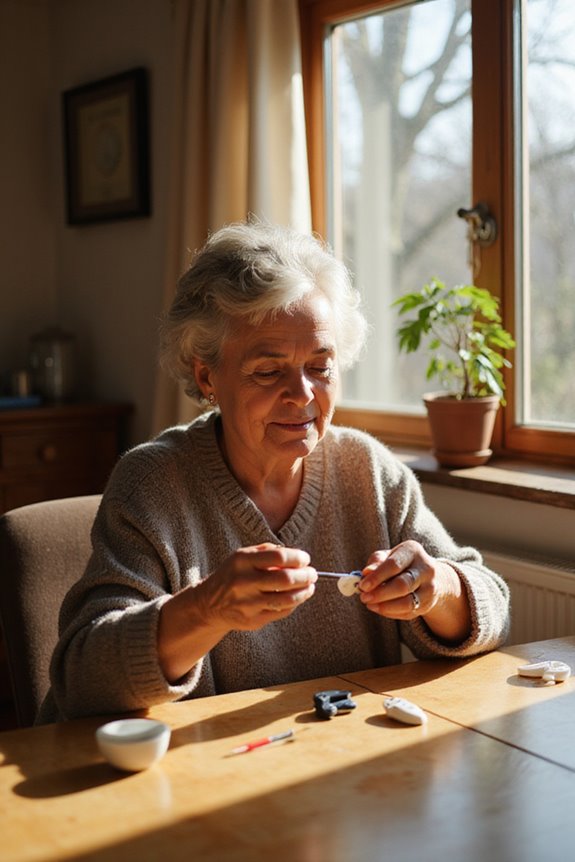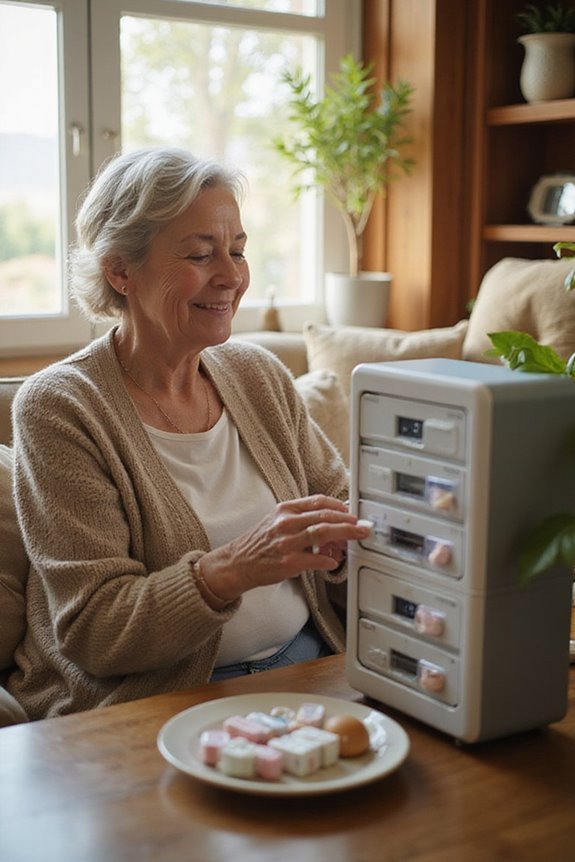Maintaining and cleaning daily living aids is critical for safety and functionality. Key practices include adhering to manufacturer cleaning instructions, using non-toxic supplies, and employing effective disinfection protocols. Regular inspections guarantee operational reliability; high-contact areas require daily disinfection. Organizing cleaning supplies enhances accessibility, while environmental adjustments support ease of cleaning. Encouraging independence in cleaning tasks fosters user confidence and autonomy. For further insights on enhancing cleaning routines and best practices, additional information is provided.
Key Takeaways
- Follow manufacturer’s cleaning instructions to enhance the longevity and performance of daily living aids while avoiding potential hazards and warranty voids.
- Use non-toxic cleaning agents and specialized tools like microfiber cloths to effectively clean surfaces without causing harm.
- Disinfect high-contact areas daily with EPA-approved solutions, ensuring surfaces are pre-cleaned for maximum effectiveness.
- Encourage independence by teaching step-by-step cleaning routines and providing adaptive tools for easier maintenance of daily living aids.
- Organize cleaning supplies within reach and optimize space layout to make cleaning routines easier and promote user autonomy.
Understanding Manufacturer’s Cleaning Instructions
Understanding the manufacturer’s cleaning instructions is essential for users of daily living aids, as adherence to these guidelines can greatly enhance both the equipment’s longevity and performance.
Importance of Manufacturer Recommendations
- Safety Precautions: Guidelines prevent hazards like electrical shock.
- Specific Cleaning Agents: Recommended products avoid material damage.
- Disinfection Protocols: Instructions detail effective disinfectant use and duration.
- Maintenance Schedules: Regular cleaning extends equipment life.
Risks of Non-Compliance
- Equipment Damage: Incorrect products can accelerate wear.
- Health Risks: Poor cleaning may harbor bacteria.
- Warranty Voidance: Non-adherence can nullify warranties.
Conclusion
User compliance with these instructions is vital for ensuring safety, effectiveness, and the integrity of daily living aids, fostering trust in their functionality. Additionally, following these guidelines can help maintain mattress hygiene and protect against allergens, similar to how proper cleaning practices enhance the performance of daily living aids.
Essential Cleaning Supplies for Daily Living Aids
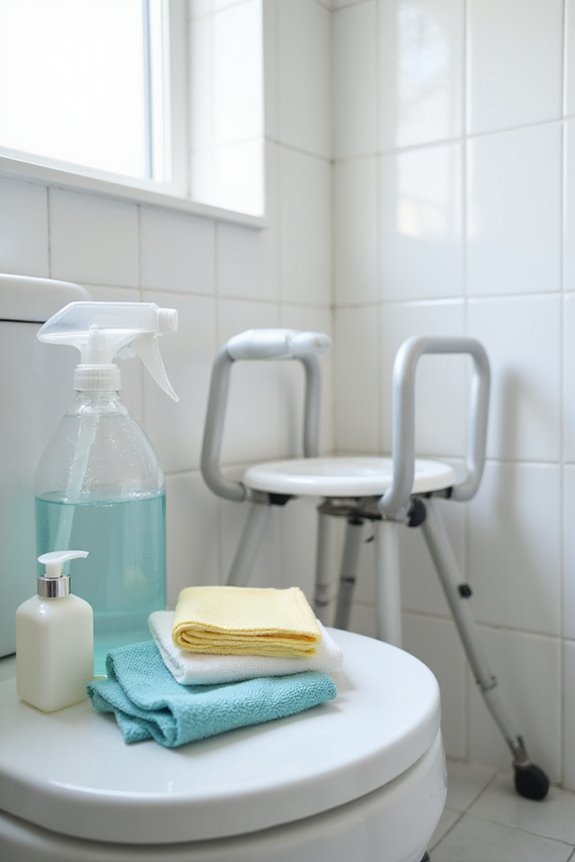
Essential cleaning supplies play a crucial role in the upkeep of daily living aids, ensuring they remain functional and hygienic. Key components include:
- Non-Toxic Cleaning Agents: White vinegar and baking soda are effective and safe. Plant-based cleaners, such as Mrs. Meyer’s, minimize irritation.
- Specialized Tools: Microfiber cloths and disposable wipes prevent cross-contamination, while Magic Eraser sponges tackle tough stains.
- Hygienic Add-Ons: Water-repellent sprays and dehumidifiers protect from moisture-related issues.
- Ready-to-Use Solutions: Detergent pods and no-rinse products simplify maintenance.
- Storage Options: Portable caddies and labeled containers enhance organization.
Implementing a consistent cleaning schedule with these eco-friendly options not only preserves the integrity of daily living aids but also fosters a sense of community and shared responsibility among users and caregivers.
Daily Surface Cleaning Techniques
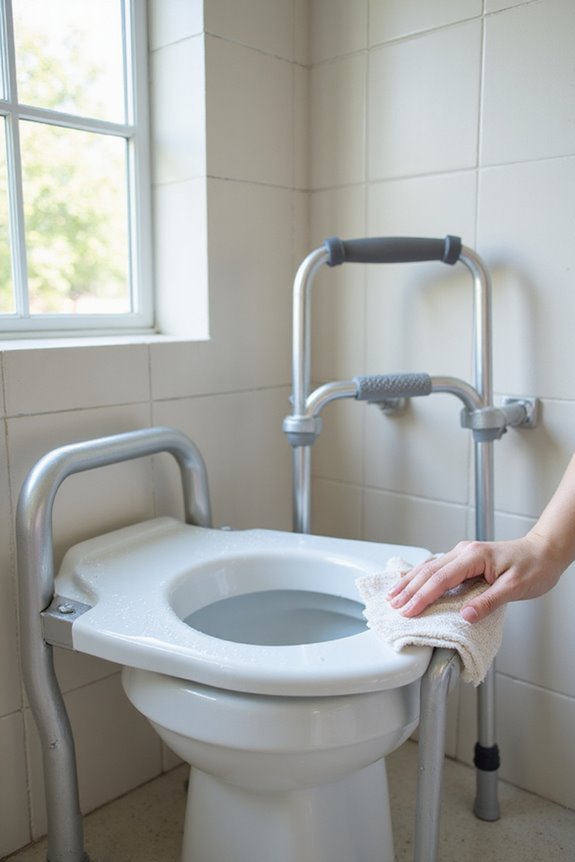
Daily surface cleaning techniques are essential for maintaining the hygiene and functionality of daily living aids. Proper preparation is vital; individuals should remove clutter, select compatible cleaning tools, and gather supplies upfront.
Pre-Cleaning: Remove loose debris and spot clean stains.
Main Cleaning: Apply sufficient cleaning solution, ensuring to agitate surfaces and follow wipe patterns.
Rinsing and Drying: Rinse surfaces as needed, wipe down with microfiber cloths, and allow areas to air dry completely.
Maintaining Cleanliness: Incorporate daily wiping routines and monitor cleaning tools for cross-contamination. Regularly check for wear on surfaces.
Implementing these daily surface cleaning techniques fosters a hygienic environment, supporting the well-being of users of daily living aids.
Effective Disinfection Protocols
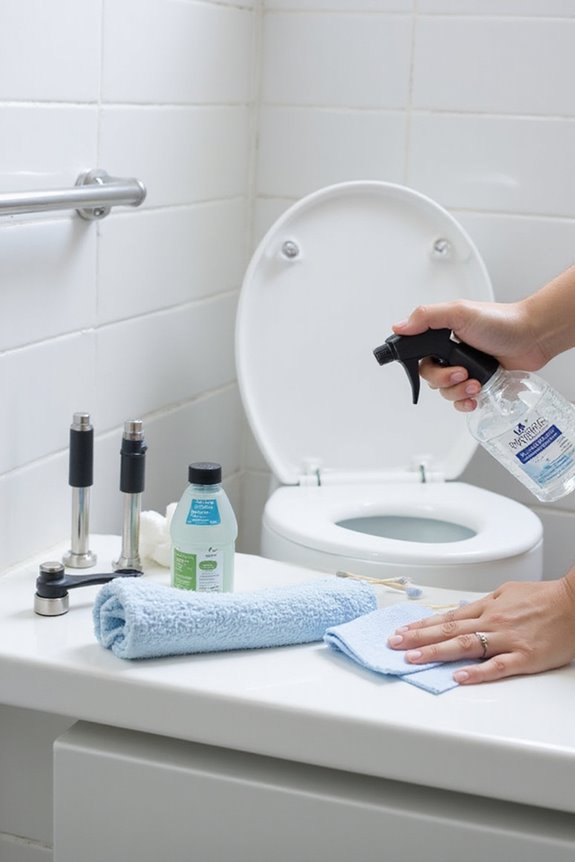
Effective disinfection protocols are paramount for guaranteeing the safety and hygiene of daily living aids. Implementing these protocols requires adherence to specific guidelines to achieve ideal disinfectant effectiveness and microbial control.
Essential Disinfectants:
- Use EPA-approved disinfectants for noncritical surfaces.
- In their absence, a bleach solution (1/3 cup per gallon of water) serves as an alternative.
- Alcohol-based solutions (70%) are appropriate for certain materials.
Best Practices:
- Pre-clean surfaces to enhance disinfectant effectiveness.
- Follow recommended contact times for thorough microbial inactivation.
- Standardize protocols for consistency across all aids.
Frequency and Safety:
- Disinfect daily, particularly high-contact and moisture-prone areas.
- Use personal protective equipment and guarantee proper ventilation during application.
Routine Maintenance and Inspection Practices
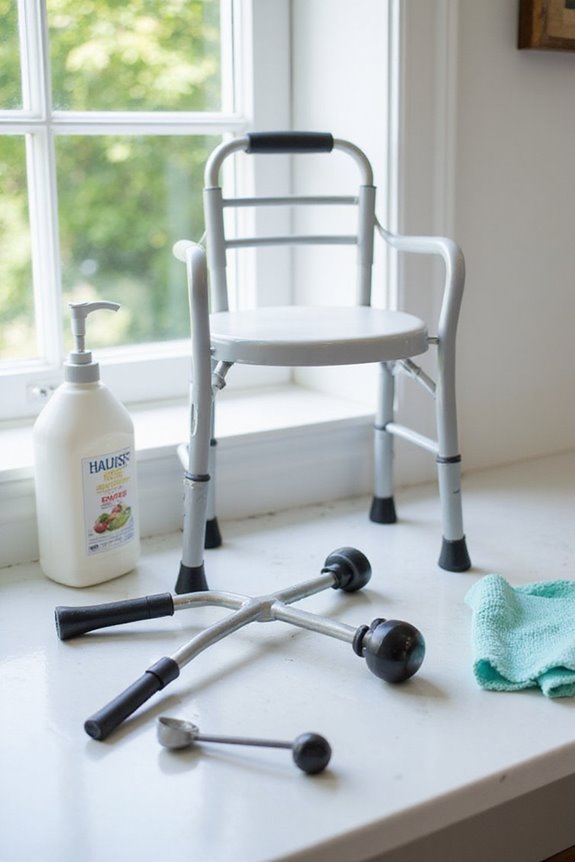
Routine maintenance and inspection practices are essential for ensuring the ideal performance and longevity of daily living aids. Regular visual inspections should be scheduled weekly for most aids, while advanced equipment requires monthly or yearly deep checks. Maintenance logs must document each inspection for accountability, ensuring that any identified issues are promptly addressed.
Equipment-specific protocols include reviewing manufacturer guidelines and tailoring maintenance to each device type, checking moving parts for wear. Functional testing is critical; it verifies device operability and safety. Users should perform function tests on mobility aids, checking brakes and battery function. By adhering to systematic inspection practices, caregivers can foster a safe and reliable environment, promoting the well-being of individuals who depend on these aids. Additionally, regular checks on battery life ensure that devices remain operational during extended use away from power sources.
Proper Storage and Handling of Aids
Proper Storage and Handling of Aids
Proper storage and handling of daily living aids play a significant role in their longevity and functionality, building on the foundation established by routine maintenance practices.
- Store aids in cool, dry places to prevent corrosion and mold.
- Avoid direct sunlight and heat sources to protect materials and batteries.
- Guarantee adequate ventilation to reduce moisture and odors.
- Use compact configurations for space optimization and designate specific storage areas for easy accessibility solutions.
- Employ protective covers to prevent dust and accidental damage.
- Secure high-value aids in locked locations to enhance storage safety.
- Conduct regular inspections and document repairs to maintain accountability.
Implementing these practices guarantees that daily living aids remain functional and safe for users. Additionally, it is essential to consider the measurement accuracy of devices like thermometers when ensuring their reliability in various environments.
Cleaning Tips for Users With Limited Mobility
Cleaning can be a challenging task for individuals with limited mobility, yet employing adaptive tools and techniques can greatly improve their ability to maintain a clean living environment.
Adaptive Equipment
- Lightweight, ergonomic tools minimize physical strain.
- Long-handled dusters and mops facilitate reaching high or low surfaces without bending.
- Power scrubbers and robotic vacuums reduce effort in cleaning routines.
Modifying Cleaning Techniques****
- Break down tasks into smaller steps to reduce fatigue.
- Prioritize health-impacting areas, like kitchens and bathrooms.
- Take scheduled breaks to prevent overexertion.
Safety Considerations
- Maintain clear walkways to avoid tripping hazards.
- Store supplies within easy reach to minimize strain.
- Use non-toxic cleaning products to reduce health risks. Additionally, utilizing ergonomic kitchen tools can further enhance safety and efficiency in cleaning routines.
These strategies promote a cleaner, safer living space for users with limited mobility.
The Importance of Regular Cleaning
Regular cleaning of daily living aids is essential for maintaining health and safety standards. Adhering to a proper cleaning frequency reduces the buildup of germs, bacteria, and allergens, thereby minimizing infection risks.
Key health benefits include:
- Prevention of pathogen spread, especially on frequently touched items, such as mobility aids and utensils.
- Reduction in respiratory and skin-related illnesses through maintained hygiene.
- Decreased allergic reactions due to the removal of dust and debris.
Moreover, regular cleaning prolongs the functional reliability of aids, enhancing mobility and independence. Clean equipment promotes user confidence, reducing fall risks and improving overall quality of life. Ultimately, consistent cleaning routines foster awareness about hygiene, ensuring that both users and caregivers prioritize maintenance. Additionally, it is important to consider battery life considerations when maintaining assistive listening devices to ensure optimal performance.
Encouraging Independence in Cleaning Tasks
Encouraging independence in cleaning tasks is essential for individuals utilizing daily living aids, as it not only fosters self-sufficiency but also enhances overall well-being.
Skill Development Strategies
- Establish step-by-step routines to build consistency.
- Use visual aids and checklists to reinforce memory.
- Introduce adaptive cleaning tools for ease of use.
Environmental Modifications
- Arrange supplies within easy reach to reduce strain.
- Simplify spaces by decluttering and ensuring adequate lighting.
Psychological Support
- Promote autonomy by allowing choice in tasks.
- Foster social support through group activities or buddy systems.
Training Techniques
- Conduct hands-on demonstrations focused on safety.
- Provide ongoing opportunities for practice and skill refreshment.
These motivational strategies and skill-building techniques are vital for fostering cleaning independence. Additionally, incorporating ergonomic kitchen tools can significantly enhance comfort and efficiency during cleaning tasks.
Frequently Asked Questions
How Often Should I Clean My Daily Living Aids?
Ironically, many underestimate the importance of cleaning frequency. For ideal hygiene practices, daily cleaning of high-touch surfaces is essential. Regular attention not only guarantees safety but fosters a sense of belonging and care within shared spaces.
Can I Use Vinegar to Clean My Mobility Aids?
Using vinegar for cleaning mobility aids offers benefits such as antibacterial properties and eco-friendliness. However, users must consider mobility aid safety, avoiding sensitive surfaces to prevent damage while ensuring effective hygiene practices are followed.
What Materials Should I Avoid When Cleaning?
A hypothetical case illustrates the risks of using harmful chemicals and abrasive materials. Avoid bleach on metals and abrasive cleaners that scratch surfaces, as these choices can greatly shorten the lifespan of essential aids, impacting daily life.
How Do I Remove Stubborn Stains From Surfaces?
To effectively remove stubborn stains, one can employ various stain removal techniques, utilizing surface cleaning agents like baking soda pastes or degreasers, promoting a sense of community through shared knowledge and successful cleaning experiences.
Are There Eco-Friendly Cleaning Options Available?
In a world teetering on the brink of ecological crisis, eco-friendly products and natural alternatives emerge as beacons of hope, promising cleanliness without compromise, while fostering a collective sense of belonging to a sustainable future.

